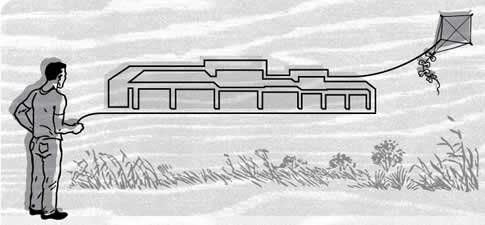
The underground comic godfather R. Crumb, drew a twelve-paneled comic in 1979 entitled “A Short History of America.” The first panel shows a forest on the edge of a field, green and lush with a flock of birds across a blue sky. By the last panel the forest is gone and the field obliterated. In its place are metal lamp poles, multilayered telephone wires and posts, a crowd of street signs and billboards, cement sidewalks, asphalt paved streets and parking lots, a traffic jam of hulking cars, TV antennas, apartment complexes, one exceedingly small patch of token greenery, and a question in the bottom right corner asking “What Next?”
What happens between those two panels is subtle. A train track is put through the forest. A road and a house are built. More houses are built. The road gets wider and is intersected by another road. A factory shows up. Soon, trolley cars, traffic lights and sidewalks appear. The last real tree is cut down. Buildings go up and get torn down or added on to. Trains and trolleys make way for cars and buses. Everything is crowded – a concrete jungle from end to end.
If you’ve ever been to the corner of Three Mile and Hammond Road, six miles southeast of Traverse City, you might notice the sprawl cells dividing rapidly. That is, if you’re new to the area. If you’ve been calling that area home for the last 15 years, you might not just be “noticing” the sprawl, you might be asking yourself, “How in the hell did this happen?”
You see, back in the proverbial day, there used to be – in the vicinity of that corner – Roy’s party store, Cherry Knoll Elementary, the East Bay branch of the public library, and the township hall. In 1992, East Junior High opened behind Cherry Knoll. Soon thereafter, a Shell Station appeared, Roy’s added a BP Station, and a Chicken Coop hatched itself north of Roy’s. Then last year, Olson’s opened up in a strip mall right on the corner. Its neighbors include a video store, a pizza joint, Espresso Bay, and a Curves fitness center. In addition to all of this, two other schools opened nearby, one south and the other east. And six hundred yards east of the intersection, another coffee shop in another strip mall abuts a road that ends at the Centre I.C.E. Arena.
Now I consider myself an environmentally conscious person with tree hugger tendencies, but I’m not going to act like some narrow-minded jackass.
Now I consider myself an environmentally conscious person with tree hugger tendencies, but I’m not going to act like some narrow-minded jackass. I understand development is, for the most part, inevitable. However, after watching Three Mile and Hammond Road start to confuse itself with Wayne County, I’ve got a few questions. For example, does it have to look like pure shit? Does it have to appear as if there’s no underlying plan to retain an area’s former appealing aesthetic? Which, if I can remember, were the open fields, trees and windswept hills – you know, Nature. A vibrant and living rural setting. Because, I’ve got to say, the current development is the equivalent of giving a giant middle finger to Nature — and to me for that matter.
But what do I expect? Giant green parks with cascading water fountain displays? Waterfowl rehabilitation facilities? A multi-tiered rose garden? No. But what I do expect is the people who live here to remember why they moved here – an escape to an area where the environment still held power in people’s eyes. An escape to an environment that made you feel good to live in. A place where one could wrap their arms around Nature and feel the love.
“People who move here from downstate continue to add to the problem of urban sprawl,” writes outdoor enthusiast David Richey. “They come north with bright hopes of moving into an idyllic location, and they bring their downstate baggage with them.”
He’s not the only local resident to have such thoughts. It would be easy to grumble about downstaters “ruining” our area. But let’s see this through more realistic eyes.
I spent six years living in southern Michigan, and Traverse City is a paradise compared to those Bowels of Hell. Let’s say you grew up in the Detroit area. You’re used to urban sprawl on an unfathomable level. You’re used to a complex web of highways, long commutes, gray concrete plastered everywhere, and backgrounds consisting of ugly, horrifying industrial plants. You’re used to driving to strip malls to shop – you don’t think twice about it. Many people moving to Traverse City bring this attitude with them. Like David Richey states, they also bring baggage. But it is more a frame-of-mind – they can’t help but give back what they’ve learned. Even those that aren’t directly responsible for sprawl contribute to the problem by not being outraged – they just don’t understand what the big deal is. It’s normal for them. In fact, it might be comforting.
Yet, as I’ve said, it’s hardly just our new neighbors who deserve the blame. In an article entitled, “Breaking the Sprawl Addiction,” Keith Schneider writes, “Garfield [township] planned for a sprawling pattern of economic growth. They mapped out a conventional zoning plan in the early 1970s that devoted thousands of acres to new businesses, subdivisions, malls, and one-story office complexes.”
A lot of us remember when the Grand Traverse Mall and the Wal-Mart strip mall were just two open fields.
A lot of us remember when the Grand Traverse Mall and the Wal-Mart strip mall were just two open fields. Now they’re simply good examples of how to make a giant clusterfuck with ample parking. Some people can even recall when the Cherryland Plaza was an open field before being converted into an unsightly, low-slung building in the middle of wall-to-wall asphalt carpeting. Ask anybody if they like driving through Garfield Township and the answer will usually end with, “I avoid it when I can.”
Maybe township planners can’t think very far ahead. Maybe the sprawl is the result of the “free market” – a sign of economic growth encouraged by cheap lot prices and tax breaks. This is certainly not an area of my expertise. But I grew up here, and I remember when it felt better to live here.
Now, I’m not trying to paint some over-the-top horror story about how Traverse City is ruined forever. I still think it’s beautiful here, but we are losing our environment to this strip mall mentality – little by little, tree by tree, and field by field. And this is just the beginning. Wait another fifteen years and much of our outlying areas will look like a suped-up version of Three Mile and Hammond. We will not be able to escape or avoid similarities to Woodward Ave. in Detroit.
Sprawl is occurring in every region across the state – across all states. It’s accepted. It’s perceived as normal. It’s our modern American architectural solution to life. We will make Nature ours, and our version of Nature won’t seem very natural – or livable – when we’re finished. What can we do to reverse the trend? For starters, we can ditch the notion that business, efficiency, and automobile access are the only variables worth taking into account when planning for growth. There’s also peace of mind.





No Comments so far ↓
There are no comments yet...Kick things off by filling out the form below.